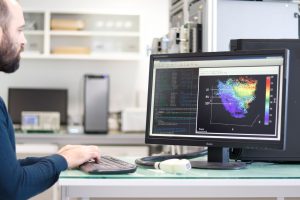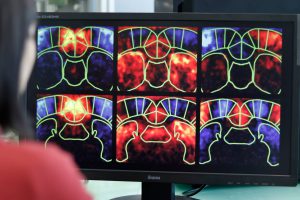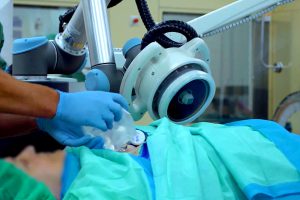Beyond the fundamental limitations of ultrasound
Our researchers are actively involved in the expansion of ultrasound imaging by translating innovative concepts of wave physics to new methods for medical screening, diagnosis and therapy.
Ultrafast ultrasound imaging has been introduced in 1996, enabling to image the human body at more than 10000 frames per second whereas standard ultrasound scanners operate at 50 frames per second. Ultrafast imaging captures dynamic physiological phenomena (tissue vibrations, muscular contraction, blood flows) which are otherwise unobservable, improving the diagnosis in many medical applications. Different imaging modes relying on ultrafast ultrasound can even be combined into a single technology, providing a multiparametric imaging tool for a comprehensive diagnosis.
Ultrasound Doppler is the use of ultrasound for blood flow imaging. So far, conventional Doppler techniques could only perform either a qualitative mapping of the vessels or a local (i.e. in a single pixel) quantitative measurement of the blood velocity. Conversely, ultrafast ultrasound enables the synchronous recording of a large amount of data, which ultimately provides a 20-times higher sensitivity compared to conventional Doppler. Besides, ultrafast Doppler can simultaneously map and quantify the blood velocities in every pixel of the imaging area.
The vascular network can be mapped at depth in organs with a micron scale resolution, using ultrafast ultrasound imaging to track the trajectory of microbubbles injected in the blood stream. Microbubbles are routinely used in clinics as ultrasound contrast agents (i.e. in order to enhance the contrast of ultrasound images), with thousands of bubbles injected during an examination. With ultrafast imaging rates, microbubbles can be distinguished individually and the exact location and travel speed of each bubble recovered. The method, coined ultrasound super-localization microscopy, closely parallels the optical super-localization microscopy approach (invented by Betzig, Moerner and Hell, recipients of the 2014 Nobel Prize of Chemistry). Ultrasound super-localization microscopy combines the centimetric imaging depth of ultrasound waves with a micron scale resolution.




